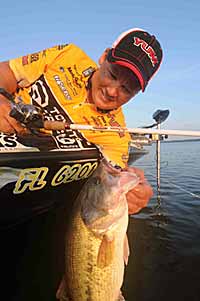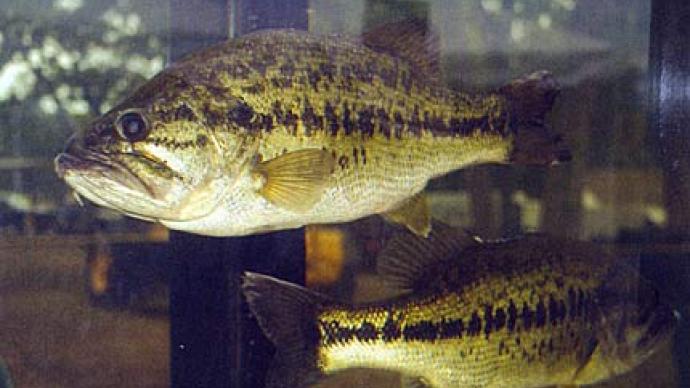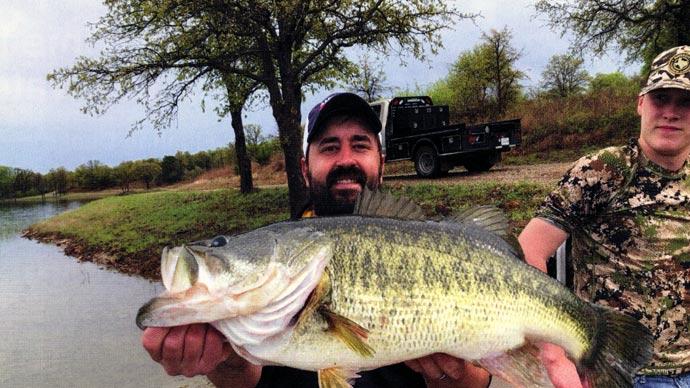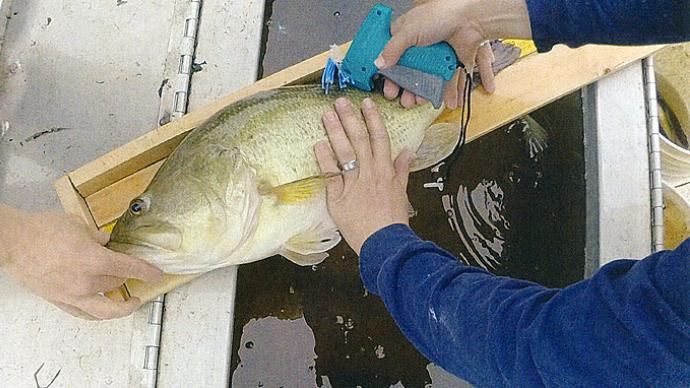
In all those "ball" sports, the ability to make the pitch, shoot the basket, sink the putt, or thread the ball between two defenders when the chips are down, the money is on the line, and the pressure on, is what separates the men from the boys, the professional from the amateur. The same is true for bass fishing, particularly tournament fishing - largely because of the way bass are made.
Bass are strongly visual animals. As judged by the amount of brain tissue they devote to visual stimuli, vision may be their dominant sense. Estimates of how far bass can see under water vary. Most vision experts cite about 50 feet as the maximum. Beyond that distance all objects disappear into a "blue haze" due to light absorption and scattering by the water.
Of course, the size of the visual target makes a big difference. Bass probably see full grown bluegills a lot further off than they see baby minnows. Size matters because larger objects cast larger images on the retina at the back of the bass' eye. Larger images, in turn, stimulate a greater number of optic nerve cells, sending a stronger nerve message to the brain. Some objects are so small they fail to register on the retina and hence are too tiny to be seen.
Although smaller prey can escape bass detection, bass lures lie above the minimum size limit. We know this from watching how bass react to lures. I have personally observed bass at the Berkley Fish Research Center charge crankbaits from as far away as 35-40 feet in gin-clear water. Whether they see these same lures from even greater distances is a matter of speculation.
But let's suppose for a moment that, under the best conditions, bass can see prey up to 50 feet away. That might not seem like very far to you and me, but to a 1- to 2-foot bass, that distance could be imposing, especially for feeding. In fact, it might be a little too imposing. Chasing down every prey within a 50-foot radius could prove exhausting.
And, of course, not every meal turns out to be real. From 50 feet away a fluttering leaf might easily be mistaken for a struggling, injured minnow. A bass rushing in for the kill would make the trip for nothing. Energetically speaking, that's a big waste. For an animal that's trying to live on a net gain of energy, the bass can't afford too many of these fruitless excursions.
So what's a hungry bass with a visual attitude to do? It must eat but can't afford costly miscues. Simple. It plays the odds.
Biologists have long recognized that predatory fish like bass often limit themselves to strike distances much shorter than what they see. At any given time, the bass has a maximum distance it will commit to, to charge on prey. This distance is called the "reaction distance" and the volume of space bounded by this length is called the "reaction zone." Bass anglers know it better as the "strike zone."
In a nutshell, the strike zone describes a space - an imaginary bubble, so to speak - around the bass wherein the bass has a high probability of successfully capturing its prey. Although the bass doesn't actually think of it this way, and the basis of the behavior is instinctive, it is merely playing a numbers game. Just like a batter works to improve his chances of getting a hit by laying off pitches outside the strike zone, bass play the odds of positive energy intake by refusing scrumptious tidbits effectively beyond their reach. It "knows" through instincts, finely honed through experience, that outside the strike zone its chances of capturing the prey fall off rapidly. That is not to say the bass never commits beyond that distance, or always fails in its efforts, only that the probability is low.
It is important to note that although we talk about the reaction distance as though it were a single value, in fact it's not. That's because the strike zone is not a perfect sphere surrounding the bass, having the reaction distance as its radius. Instead, the zone has an irregular shape due to the way bass are made. It has built-in biases.
Using its powerful tail as its main driver, a bass is built to launch forward, not sideways or backwards. For that reason, the strike zone is forward biased. In other words, the bass is much more likely to strike at potential prey lying directly ahead in front of its face than to the sides or behind. There is also a positive vertical bias. When attacking, bass tend to position themselves where they can strike upwards, coming up from underneath the prey. Thus, the reaction distance reaches its maximum slightly above the fish's horizontal plane. It quickly shortens for targets located to the side and/or below the horizontal plane.
Another reason the strike zone is not perfectly symmetrical is because portions of the bass' body interfere with the visual field of the eyes. For example, the area directly behind the bass is blocked from view by the flaring gills and the curvature of the stomach. Likewise, the bass cannot see directly beneath itself due to the way the eyes are set towards the top of the skull. These areas represent "blind spots" for the bass, places where prey can hide from the searching eyes of their rabid predator.
The shape of the strike zone is fairly constant, a function of how bass are made. However, the size of the zone is not constant at all. Zone size fluctuates according to the feeding mood, or aggression level of the bass. The strike zone is comparatively large when aggressiveness is high, such as when the bass is hungry or feeling particularly pugnacious. It is smaller when the bass is satiated, sick, or stressed.
Zone size also varies according to prey type and, if the prey is moving, the direction of movement. Bass will have shorter reaction distances - and, therefore, smaller strike zones - for highly mobile, agile prey: longer reaction distances for slow moving prey. Prey moving away from the bass are less likely to be attacked, or will be attacked from shorter distances, than prey moving towards the bass or across its strike zone.
Though you may not realize it, strike zones have a huge effect on your success as a bass angler. Bass treat lures essentially like they treat natural prey. That's why we call them "lures" in the first place. For that reason, all the strike zone rules that govern attacks on prey apply to lures as well. Simply put, if you want a higher rate of success you have to place your lures within the strike zone. Beyond the zone your chances drop off dramatically.
Strike zones and the limitations they impose on bass willingness to pursue lures are why you, as the angler, must be capable of making precise casts, under intense pressure if necessary, if you ever hope to be successful in tournament fishing. Bass fishing is not a passive sport. It requires an active hunting style replete with frequent cast and retrieves. And just as with the ball sports, there will be times when your own performance - consistently making the critical casts when you have to, putting the lure in the bass' face - will be all that sets you apart from the competition. True, precision casting won't always be necessary. When bass are actively hunting and their strike zones are large, just dropping your lures somewhere reasonably close to the bass will be all that's needed. Even novice anglers will be able to do that. But somewhere the times will come when the strike zones seem almost miniscule. If you're not ready to regularly place your casts right in the sweet spot time and time again, chances are you won't be standing in the winner's circle at the end of the day. The difference between success and failure may truly come down to mere inches one way or the other.
So keep practicing the fundamentals of casting and who knows, perhaps the world will next turn its fascination to you as the Tiger Woods of bass fishing.
Reprinted with permission from Bass West Magazine



